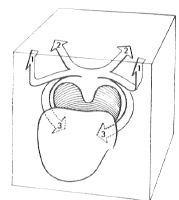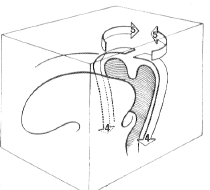Soft Palate Basics
- This post is available for download as an audio file, so you can do the work along with the recording.
 The roof of your mouth is divided into two parts: the hard palate, which extends from the back of your upper teeth to the middle of your mouth, and the soft palate, which is the back part of the roof of your mouth. If you have a mirror handy, try looking at your soft palate now. You'll probably notice first the 'little-hangy-downy-thingy' in the middle at the back, called the uvula, which is Latin for "small grape." Sometimes called the velum, the soft palate is moved around by a complex series of muscles that can lift it up, pull it down, contract it, or stretch it wide. When speaking, the soft palate lifts or drops, depending on what sound you're making. On sounds like a hum, (mmmmm), your soft palate drops to allow air to flow out your nose. When you make a /t/ or /d/ sound, your soft palate lifts to stop air from leaking out your nose.
The roof of your mouth is divided into two parts: the hard palate, which extends from the back of your upper teeth to the middle of your mouth, and the soft palate, which is the back part of the roof of your mouth. If you have a mirror handy, try looking at your soft palate now. You'll probably notice first the 'little-hangy-downy-thingy' in the middle at the back, called the uvula, which is Latin for "small grape." Sometimes called the velum, the soft palate is moved around by a complex series of muscles that can lift it up, pull it down, contract it, or stretch it wide. When speaking, the soft palate lifts or drops, depending on what sound you're making. On sounds like a hum, (mmmmm), your soft palate drops to allow air to flow out your nose. When you make a /t/ or /d/ sound, your soft palate lifts to stop air from leaking out your nose.
Try this experiment: say "hit" and don't release the final /t/ sound. Make the /t/, but don't let your tongue release the air. You may feel the air pressure pushing on the top of your tongue, and you may feel a gentle pressure at the back of the roof of your mouth as the air pushes against your closed velum or soft palate.
Another way to feel your soft palate is to simulate snoring. When you snore, your soft palate relaxes down and "flaps in the wind." I find that a little snoring helps to wake up sensation in your soft palate before we begin to work it. Have a go now.
 The soft palate is also used as part of the swallowing mechanism. Try swallowing, and feel the muscles of the tongue and the soft palate contract and push saliva down your throat. The action of making sound is the opposite of swallowing; we want the soft palate to lift and open to allow the sound of your voice out.
The soft palate is also used as part of the swallowing mechanism. Try swallowing, and feel the muscles of the tongue and the soft palate contract and push saliva down your throat. The action of making sound is the opposite of swallowing; we want the soft palate to lift and open to allow the sound of your voice out.
One involuntary action that lifts the soft palate is the yawn. See if you can consciously create a yawn to feel the soft palate lift. Do you feel how the tongue tends to contract back and downward and the soft palate lifts? Yawns are a great way to begin waking up the soft palate, but that downward contraction of the tongue is, again, contrary to the goals of voice work.
The Inhaled Kah
[Though this is my version of this soft palate exercise, it is fundamentally a classic Warren-Linklater exercise, and full instructions can be found in Kristin Linklater's Freeing the Natural Voice: Imagery and Art in the Practice of Voice and Language. on page 162.]
The consonant in English that connects most directly to the soft palate is the /k/ sound. Try making a few exploratory "kuh" sounds. See if you can feel your tongue tip behind your lower front teeth, and the body of it rising up to touch your soft palate. Now try saying "kee" and see if you can feel that the body of your tongue touches a little bit further forward on the roof of your mouth. Now try making a very far back "kaaaah", with the same vowel as father.
The next step is to inhale a whispered "kaaah" sound, allowing your jaw to relax down and open, letting your tongue tip rest behind your lower front teeth. Alternate inhaling and exhaling on whispered "kaah", feeling how the soft palate instinctively lifts as you inhale.
Can you feel how the soft palate tends to relax on the exhalation while it is energized upwards on the inhalation? Try to preserve the feeling of lift as you exhale on the whispered "kaah", continuing with the alternation of inhale and exhale. It's helpful to think "LIFT!" as you inhale and then "LIFT!" again as you exhale.
Now that you can do this with a whisper, let's add another dimension: continue to whisper the inhaled "kaah", and then voice the exhaled version. Keep trying to find the feeling of LIFT! as you sound on "kaah," transferring the feeling from the inhaled whisper to the exhaled voiced sound.
Finally, sigh out some gentle "huh" sounds, and see if you can visualize your soft palate floating up and back, getting out of the way for the sound to pour out of you. It's important that your tongue relax inside your mouth and your jaw drop, in order to create a very open, relaxed feeling below the energized soft palate.
Next Step: Face Awakening
Excellent!!! Very thorough, yet easy to understand.
Thank you…
This is fantastic stuff. Thanks so much for making it available. I’m a beginning voice student and have searched in vain for any info on the soft palate that actually makes sense and can be understood by a beginner. Your site is the first I’ve found that actually makes sense!
Thank you for writing this article. I stammer and I’m realising how learning to control my soft palate can assist me in controlling my speech.
Best Regards
I have mild sleep apnea and I was told by an ENT specialist that my soft palate was the source of my issues (too long or soft).
I tried these exercises and I have to say: I no longer need the CPAP (I’m quick to place it down, and I still feel a bit tired, so talk to your doctor).
I did a 2nd sleep study and the apneas have decreased significantly!
it was such a very good content. I am genuinely awaiting our next article.
I have been told that the gateway to the top of the voice in up and behind the soft palate, entering into the nasal passages. For this to happen, doesn’t the
soft palate have to come down some?
Please respond.
Thanks much for the article.
If the soft palate “comes down” then the tone of the voice will become nasal. There are styles of voice use, including some singing and speaking styles (and even some dialects/accents) where this is entirely acceptable. However, in other styles, it is unacceptable. In fact, I believe that what you’re getting at is a sound that is created by lifting the soft palate, usually very high, so that there is space at the back of the mouth. So it isn’t actually “behind” the palate. If you do want the sound to go into the nasal passages, then, yes, the soft palate MUST come down. One way to test: plug your nose. You can immediately feel if the soft palate is down or up.
I am a voice teacher. This is a wonderful article…I love new ideas! Thank you.